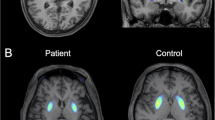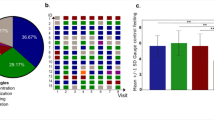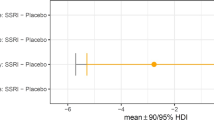Abstract
Lenrispodun is a potent and highly selective inhibitor of phosphodiesterase (PDE) type 1, which is thought to prolong intracellular second messenger signaling within cortical and subcortical dopaminergic brain regions. This is the first study of a PDE1 inhibitor in healthy volunteers using behavioral and neuroimaging approaches to examine its effects on neural targets and to provide a safety and tolerability assessment. The primary objectives were to determine whether lenrispodun induces changes in BOLD fMRI signals in the inferior frontal gyrus (IFG) during the stop signal task, and the dorsal anterior insula (dAI) during the extinction phase of a fear conditioning/extinction task. Using a double-blind, placebo-controlled, within-subjects design, 26 healthy individuals (22 completed all fMRI sessions) received in random order a single oral dose of placebo, lenrispodun 1.0 milligram (mg) or lenrispodun 10.0 mg and completed several tasks in the scanner including the stop signal (n = 24) and fear conditioning/extinction tasks (n = 22). Prespecified region-of-interest analyses for the IFG and dAI were computed using linear mixed models. Lenrispodun induced increases in IFG activity during the stop signal task at 1.0 mg (Cohen’s d = 0.63) but not 10.0 mg (Cohen’s d = 0.07) vs. placebo. Lenrispodun did not induce changes in dAI activity during fear extinction at either dose. Exploratory outcomes revealed changes in cardiac interoception. Lenrispodun administration was well-tolerated. These results provide evidence that 1.0 mg lenrispodun selectively improved neural inhibitory control without altering fear extinction processing. Future investigations should determine whether lenrispodun improves inhibitory control in target populations such as individuals with attention deficit hyperactivity disorder. Trial registration: ClinicalTrials.gov identifier: NCT03489772.
Similar content being viewed by others
Log in or create a free account to read this content
Gain free access to this article, as well as selected content from this journal and more on nature.com
or
References
Rose GM, Hopper A, De Vivo M, Tehim A. Phosphodiesterase inhibitors for cognitive enhancement. Curr Pharm Des. 2005;11:3329–34.
Rutten K, Prickaerts J, Hendrix M, van der Staay FJ, Sik A, Blokland A. Time-dependent involvement of cAMP and cGMP in consolidation of object memory: studies using selective phosphodiesterase type 2, 4 and 5 inhibitors. Eur J Pharmacol. 2007;558:107–12.
Rodefer JS, Saland SK, Eckrich SJ. Selective phosphodiesterase inhibitors improve performance on the ED/ID cognitive task in rats. Neuropharmacology. 2012;62:1182–90.
Reneerkens OA, Rutten K, Bollen E, Hage T, Blokland A, Steinbusch HW, et al. Inhibition of phoshodiesterase type 2 or type 10 reverses object memory deficits induced by scopolamine or MK-801. Behav Brain Res. 2013;236:16–22.
Reneerkens OA, Sambeth A, Blokland A, Prickaerts J. PDE2 and PDE10, but not PDE5, inhibition affect basic auditory information processing in rats. Behav Brain Res. 2013;250:251–6.
Li P, Zheng H, Zhao J, Zhang L, Yao W, Zhu H, et al. Discovery of potent and selective inhibitors of phosphodiesterase 1 for the treatment of cognitive impairment associated with neurodegenerative and neuropsychiatric diseases. J Med Chem. 2016;59:1149–64.
Snyder GL, Prickaerts J, Wadenberg ML, Zhang L, Zheng H, Yao W, et al. Preclinical profile of ITI-214, an inhibitor of phosphodiesterase 1, for enhancement of memory performance in rats. Psychopharmacology. 2016;233:3113–24.
Humphrey JM, Movsesian M, Am Ende CW, Becker SL, Chappie TA, Jenkinson S, et al. Discovery of potent and selective periphery-restricted quinazoline inhibitors of the cyclic nucleotide phosphodiesterase PDE1. J Med Chem. 2018;61:4635–40.
Hashimoto T, Kim GE, Tunin RS, Adesiyun T, Hsu S, Nakagawa R, et al. Acute enhancement of cardiac function by phosphodiesterase type 1 inhibition. Circulation. 2018;138:1974–87.
Gilotra NA, DeVore AD, Povsic TJ, Hays AG, Hahn VS, Agunbiade TA, et al. Acute hemodynamic effects and tolerability of phosphodiesterase-1 inhibition with ITI-214 in human systolic heart failure. Circ Heart Fail. 2021;14:e008236.
Golshiri K, Ataei Ataabadi E, Rubio-Beltran E, Dutheil S, Yao W, Snyder GL, et al. Selective phosphodiesterase 1 inhibition ameliorates vascular function, reduces inflammatory response, and lowers blood pressure in aging animals. J Pharmacol Exp Ther. 2021;378:173–83.
O’Brien JJ, O’Callaghan JP, Miller DB, Chalgeri S, Wennogle LP, Davis RE, et al. Inhibition of calcium-calmodulin-dependent phosphodiesterase (PDE1) suppresses inflammatory responses. Mol Cell Neurosci. 2020;102:103449.
Congdon E, Altshuler LL, Mumford JA, Karlsgodt KH, Sabb FW, Ventura J, et al. Neural activation during response inhibition in adult attention-deficit/hyperactivity disorder: preliminary findings on the effects of medication and symptom severity. Psychiatry Res. 2014;222:17–28.
Pliszka SR, Glahn DC, Semrud-Clikeman M, Franklin C, Perez R 3rd, Xiong J, et al. Neuroimaging of inhibitory control areas in children with attention deficit hyperactivity disorder who were treatment naive or in long-term treatment. Am J Psychiatry. 2006;163:1052–60.
Fullana MA, Albajes-Eizagirre A, Soriano-Mas C, Vervliet B, Cardoner N, Benet O, et al. Fear extinction in the human brain: a meta-analysis of fMRI studies in healthy participants. Neurosci Biobehav Rev. 2018;88:16–25.
Heimer L, Van Hoesen GW. The limbic lobe and its output channels: implications for emotional functions and adaptive behavior. Neurosci Biobehav Rev. 2006;30:126–47.
Fadok JP, Dickerson TM, Palmiter RD. Dopamine is necessary for cue-dependent fear conditioning. J Neurosci. 2009;29:11089–97.
Abraham AD, Neve KA, Lattal KM. Dopamine and extinction: a convergence of theory with fear and reward circuitry. Neurobiol Learn Mem. 2014;108:65–77.
Ikegami M, Uemura T, Kishioka A, Sakimura K, Mishina M. Striatal dopamine D1 receptor is essential for contextual fear conditioning. Sci Rep. 2014;4:3976.
Abraham AD, Cunningham CL, Lattal KM. Methylphenidate enhances extinction of contextual fear. Learn Mem. 2012;19:67–72.
McAllister TW, Zafonte R, Jain S, Flashman LA, George MS, Grant GA, et al. Randomized placebo-controlled trial of methylphenidate or galantamine for persistent emotional and cognitive symptoms associated with PTSD and/or traumatic brain injury. Neuropsychopharmacology. 2016;41:1191–8.
Schuckit MA, Tapert S, Matthews SC, Paulus MP, Tolentino NJ, Smith TL, et al. fMRI differences between subjects with low and high responses to alcohol during a stop signal task. Alcohol Clin Exp Res. 2012;36:130–40.
Ball TM, Knapp SE, Paulus MP, Stein MB. Brain activation during fear extinction predicts exposure success. Depress Anxiety. 2017;34:257–66.
Avery JA, Drevets WC, Moseman SE, Bodurka J, Barcalow JC, Simmons WK. Major depressive disorder is associated with abnormal interoceptive activity and functional connectivity in the insula. Biol Psychiatry. 2014;76:258–66.
Simmons WK, Rapuano KM, Kallman SJ, Ingeholm JE, Miller B, Gotts SJ, et al. Category-specific integration of homeostatic signals in caudal but not rostral human insula. Nat Neurosci. 2013;16:1551–52.
Stewart JL, Khalsa SS, Kuplicki R, Puhl M, Investigators T, Paulus MP. Interoceptive attention in opioid and stimulant use disorder. Addiction Biol. 2020;25:e12831.
Burrows K, DeVille DC, Cosgrove KT, Kuplicki RT, Tulsa I, Paulus MP, et al. Impact of serotonergic medication on interoception in major depressive disorder. Biol Psychol. 2022;169:108286.
Hariri AR, Tessitore A, Mattay VS, Fera F, Weinberger DR. The amygdala response to emotional stimuli: a comparison of faces and scenes. Neuroimage. 2002;17:317–23.
Cox RW. AFNI: software for analysis and visualization of functional magnetic resonance neuroimages. Computers Biomed Res. 1996;29:162–73.
Fan L, Li H, Zhuo J, Zhang Y, Wang J, Chen L, et al. The human brainnetome atlas: a new brain atlas based on connectional architecture. Cereb Cortex. 2016;26:3508–26.
Cools R, Frobose M, Aarts E, Hofmans L. Dopamine and the motivation of cognitive control. Handb Clin Neurol. 2019;163:123–43.
Cortés R, Gueye B, Pazos A, Probst A, Palacios JM. Dopamine receptors in human brain: autoradiographic distribution of D1 sites. Neuroscience. 1989;28:263–73.
Pekcec A, Schülert N, Stierstorfer B, Deiana S, Dorner-Ciossek C, Rosenbrock H. Targeting the dopamine D(1) receptor or its downstream signalling by inhibiting phosphodiesterase-1 improves cognitive performance. Br J Pharmacol. 2018;175:3021–33.
Enomoto T, Tatara A, Goda M, Nishizato Y, Nishigori K, Kitamura A, et al. A novel phosphodiesterase 1 inhibitor DSR-141562 exhibits efficacies in animal models for positive, negative, and cognitive symptoms associated with schizophrenia. J Pharmacol Exp Ther. 2019;371:692–702.
Betolngar DB, Mota É, Fabritius A, Nielsen J, Hougaard C, Christoffersen CT, et al. Phosphodiesterase 1 bridges glutamate inputs with NO- and dopamine-induced cyclic nucleotide signals in the striatum. Cereb Cortex. 2019;29:5022–36.
Bartoli E, Aron AR, Tandon N. Topography and timing of activity in right inferior frontal cortex and anterior insula for stopping movement. Hum Brain Mapp. 2018;39:189–203.
Aron AR, Fletcher PC, Bullmore ET, Sahakian BJ, Robbins TW. Stop-signal inhibition disrupted by damage to right inferior frontal gyrus in humans. Nat Neurosci. 2003;6:115–16.
Schachar RJ, Chen S, Logan GD, Ornstein TJ, Crosbie J, Ickowicz A, et al. Evidence for an error monitoring deficit in attention deficit hyperactivity disorder. J Abnorm Child Psychol. 2004;32:285–93.
Lipszyc J, Schachar R. Inhibitory control and psychopathology: a meta-analysis of studies using the stop signal task. J Int Neuropsychol Soc. 2010;16:1064–76.
Hauser TU, Iannaccone R, Ball J, Mathys C, Brandeis D, Walitza S, et al. Role of the medial prefrontal cortex in impaired decision making in juvenile attention-deficit/hyperactivity disorder. JAMA Psychiatry. 2014;71:1165–73.
Rubia K, Halari R, Mohammad AM, Taylor E, Brammer M. Methylphenidate normalizes frontocingulate underactivation during error processing in attention-deficit/hyperactivity disorder. Biol Psychiatry. 2011;70:255–62.
Spechler PA, Stewart JL, Kuplicki R, Paulus MP, Tulsa I. Parsing impulsivity in individuals with anxiety and depression who use Cannabis. Drug Alcohol Depend. 2020;217:108289.
Pauls AM, O’Daly OG, Rubia K, Riedel WJ, Williams SC, Mehta MA. Methylphenidate effects on prefrontal functioning during attentional-capture and response inhibition. Biol Psychiatry. 2012;72:142–9.
Nandam LS, Hester R, Bellgrove MA. Dissociable and common effects of methylphenidate, atomoxetine and citalopram on response inhibition neural networks. Neuropsychologia. 2014;56:263–70.
Howlett JR, Huang H, Hysek CM, Paulus MP. The effect of single-dose methylphenidate on the rate of error-driven learning in healthy males: a randomized controlled trial. Psychopharmacology. 2017;234:3353–60.
Fullana MA, Albajes-Eizagirre A, Soriano-Mas C, Vervliet B, Cardoner N, Benet O, et al. Amygdala where art thou? Neurosci Biobehav Rev. 2019;102:430–31.
Hassanpour MS, Simmons WK, Feinstein JS, Luo Q, Lapidus RC, Bodurka J, et al. The insular cortex dynamically maps changes in cardiorespiratory interoception. Neuropsychopharmacology. 2018;43:426–34.
Teed AR, Feinstein JS, Puhl M, Lapidus RC, Upshaw V, Kuplicki RT, et al. Association of generalized anxiety disorder with autonomic hypersensitivity and blunted ventromedial prefrontal cortex activity during peripheral adrenergic stimulation: a randomized clinical trial. JAMA Psychiatry. 2022;79:323–32.
Barrett LF, Simmons WK. Interoceptive predictions in the brain. Nat Rev Neurosci. 2015;16:419–29.
Lovero KL, Simmons AN, Aron JL, Paulus MP. Anterior insular cortex anticipates impending stimulus significance. Neuroimage. 2009;45:976–83.
Oppenheimer S, Cechetto D. The insular cortex and the regulation of cardiac function. Compr Physiol. 2016;6:1081–133.
Manuel J, Farber N, Gerlach DA, Heusser K, Jordan J, Tank J, et al. Deciphering the neural signature of human cardiovascular regulation. Elife. 2020;9:e55316.
Lebron-Milad K, Abbs B, Milad MR, Linnman C, Rougemount-Bucking A, Zeidan MA, et al. Sex differences in the neurobiology of fear conditioning and extinction: a preliminary fMRI study of shared sex differences with stress-arousal circuitry. Biol Mood Anxiety Disord. 2012;2:7.
Geuter S, Qi G, Welsh RC, Wager TD, Lindquist MA. Effect size and power in fMRI group analysis. bioRxiv. 2018. https://doi.org/10.1101/295048.
Szucs D, Ioannidis JP. Sample size evolution in neuroimaging research: an evaluation of highly-cited studies (1990-2012) and of latest practices (2017-2018) in high-impact journals. Neuroimage. 2020;221:117164.
Acknowledgements
We thank Lisa Augustine, RN, Megan Cole, RN and Dara Crittenden for assistance with participant recruitment, lenrispodun administration, and safety monitoring; Nigel Negm for assistance with blood and urine sample processing and shipment; Saint Francis Health System Cardiology for assistance with EKG review; and the LIBR MRI technologists for assistance with imaging data acquisition.
Funding
Funding for the study was provided by Intra-Cellular Therapies, Inc. SSK is supported by The William K. Warren Foundation, and the National Institute of Mental Health Grant Award Number (K23MH112949). MPP is supported by The William K. Warren Foundation, the National Institute on Drug Abuse (U01 DA041089), and the National Institute of General Medical Sciences Center Grant Award Number (1P20GM121312). The content is solely the responsibility of the authors and does not necessarily represent the official views of the National Institutes of Health.
Author information
Authors and Affiliations
Contributions
Conceptualization: MPP, KEV, and RED; Design of the work: MPP, KEV, HY, and RED; Acquisition, analysis or interpretation of the data for the work: SSK, TAV, RK, KEV, MPP, and RED; Writing—original draft: SSK, TAV, and RK; Writing—critical revisions/editing: all authors; Final approval: SSK, KEV, MPP, and RED. Agreement to be accountable for all aspects of the work, ensuring accuracy/integrity: SSK, TAV, RK, KEV, MPP, and RED. The full trial protocol may be accessed by contacting SSK.
Corresponding author
Ethics declarations
Competing interests
RED and KEV were employees of Intra-Cellular Therapies, Inc during the design and collection of study data. RED is a current employee of Intra-Cellular Therapies and may hold stock or stock options. KEV may hold stock of Intra-Cellular Therapies and is a current employee of Engrail Therapeutics and paid advisor to Evolution Research Group. MPP is an advisor to Spring Care, Inc., a behavioral health startup, he has received royalties for an article about methamphetamine in UpToDate. SSK, TAV, RK, and HY have no conflicts-of-interest related to this manuscript to disclose.
Additional information
Publisher’s note Springer Nature remains neutral with regard to jurisdictional claims in published maps and institutional affiliations.
Supplementary information
Rights and permissions
About this article
Cite this article
Khalsa, S.S., Victor, T.A., Kuplicki, R. et al. Single doses of a highly selective inhibitor of phosphodiesterase 1 (lenrispodun) in healthy volunteers: a randomized pharmaco-fMRI clinical trial. Neuropsychopharmacol. 47, 1844–1853 (2022). https://doi.org/10.1038/s41386-022-01331-3
Received:
Revised:
Accepted:
Published:
Issue date:
DOI: https://doi.org/10.1038/s41386-022-01331-3
This article is cited by
-
An overview on pharmaceutical applications of phosphodiesterase enzyme 5 (PDE5) inhibitors
Molecular Diversity (2024)



